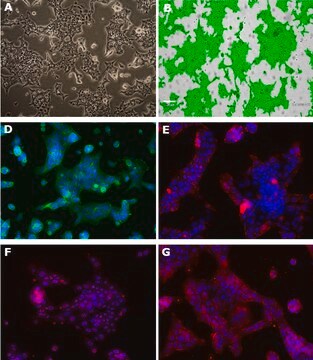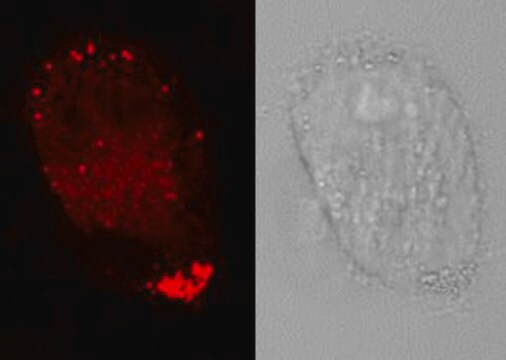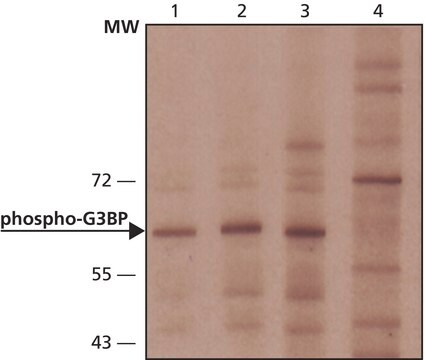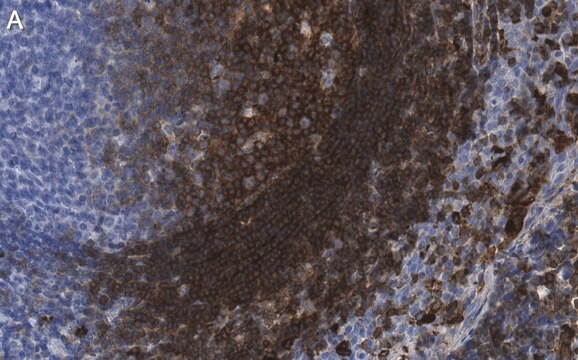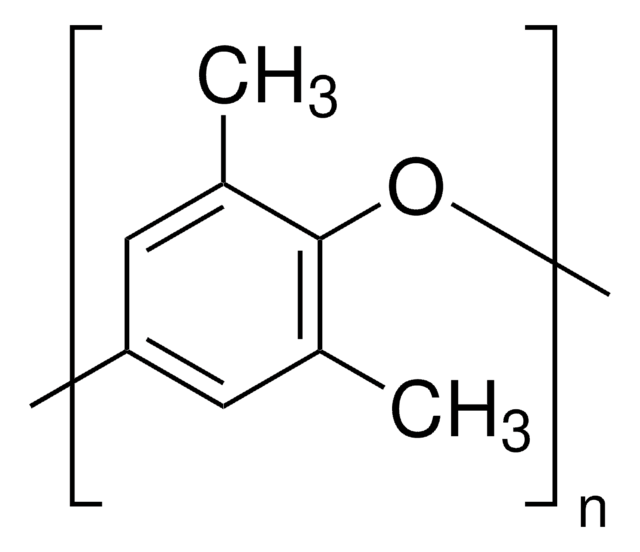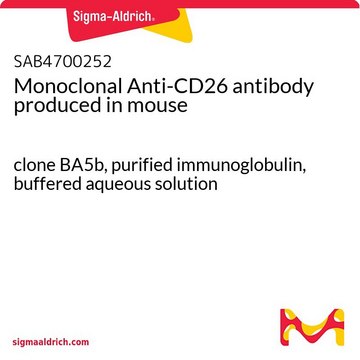SCC467
MEF SQSTM1 G427R Cell Line

Synonym(e):
MEF SQSTM1, MEF SQSTM1 G427R, MEF SQSTM1G427R
Anmeldenzur Ansicht organisationsspezifischer und vertraglich vereinbarter Preise
Alle Fotos(1)
About This Item
UNSPSC-Code:
41106514
Empfohlene Produkte
Biologische Quelle
mouse
Qualitätsniveau
Verpackung
vial of ≥1X10⁶ cells vial
Hersteller/Markenname
Millipore
Methode(n)
cell culture | mammalian: suitable
Versandbedingung
liquid nitrogen
Lagertemp.
−196°C
Anwendung
- Each vial contains > 1X106 viable cells.
- Cells are tested negative for infectious diseases by a Mouse Essential CLEAR Panel by Charles River Animal Diagnostic Services.
- Cells are verified to be of mouse origin and negative for interspecies contamination from human, rat, Chinese hamster, Golden Syrian hamster, and nonhuman primate (NHP) as assessed by a Contamination Clear panel by Charles River Animal Diagnostic Services
- Cells are negative for mycoplasma contamination.
Leistungsmerkmale und Vorteile
The MEF SQSTM1 G427R cell line contains a FLAG-tagged SQSTM1 protein in addition to the G427R mutation which can be used to study the underlying mechanisms of selective autophagy, ALS-FTLD disease pathogenesis, and oxidative stress mechanisms.
Zielbeschreibung
Amyotrophic Lateral Sclerosis (ALS) and Frontotemporal Lobar Degeneration (FTLD) are complex major neurodegenerative diseases that are not fully understood. ALS is characterized by loss of motor neurons in the brain and spinal cord while FTLD is typically characterized by degeneration of neurons in the frontal and anterior temporal lobes. Further understanding of both disorders has led them to be categorized under part of the same disease spectrum. They also share common features such as protein and protein-RNA aggregation in motor neurons. This ultimately implicates a problem in key autophagy pathways.
Recent data suggests that TBK1 and SQSTM1 mutations linked with ALS and FTLD disrupt selective autophagy, resulting in neurotoxicity.1 SQSTM1 is an autophagy receptor protein that mediates the selective autophagy of damaged cell components or proteins that frequently aggregate. The commonality of SQSTM1-associated neuronal inclusions in ALS-FTLD patients appears to indicate its importance as a cellular stress response in which SQSTM1 protein is overproduced to try and clear protein aggregates. It also functions in other signaling pathways such as oxidative stress which has emerged as a contributing factor in ALS.1 SQSTM1 helps regulate oxidative stress through the KEAP1-NFE2L2 pathway in which SQSTM1 binds with KEAP1 resulting in a downstream antioxidant response. Interestingly, a G427R mutation appears to significantly disrupt this pathway, resulting in a highly impaired NFE2L2 response.
The MEF (Mouse Embryonic Fibroblast) SQSTM1G427R cell line contains a FLAG-tagged SQSTM1 protein in addition to the G427R mutation which affects the Ubiquitin Binding Associated (UBA) domain of the SQSMT1 protein. This cell line can be utilized to continue studying the underlying mechanisms of selective autophagy, ALS-FTLD disease pathogenesis, and oxidative stress mechanisms. Furthermore, understanding of SQSTM1 and ALS-FTLD related mutations remains highly important as neurodegenerative diseases continue to increase in prevalence.
Source
Cell line was derived from immortalized p62/SQSTM1-deficient mouse embryonic fibroblasts (MEFs) which were established by infecting MEFs with a recombinant retrovirus carrying a temperature-sensitive simian virus 40 large T antigen. Flag-SQSTM1-WT was also cloned into the HindIII and Xhol sites of the LPC retroviral vector before undergoing site-directed mutagenesis to obtain the SQSTM1G427R genotype.
<underscore><bold>References</bold></underscore>
Deng Z, Lim J, Wang Q, Purtell K, Wu S, Palomo GM, Tan H, Manfredi G, Zhao Y, Peng J, et al. 2019 Jul 30. ALS-FTLD-linked mutations of SQSTM1/p62 disrupt selective autophagy and NFE2L2/NRF2 anti-oxidative stress pathway. Autophagy.:1–15.
Recent data suggests that TBK1 and SQSTM1 mutations linked with ALS and FTLD disrupt selective autophagy, resulting in neurotoxicity.1 SQSTM1 is an autophagy receptor protein that mediates the selective autophagy of damaged cell components or proteins that frequently aggregate. The commonality of SQSTM1-associated neuronal inclusions in ALS-FTLD patients appears to indicate its importance as a cellular stress response in which SQSTM1 protein is overproduced to try and clear protein aggregates. It also functions in other signaling pathways such as oxidative stress which has emerged as a contributing factor in ALS.1 SQSTM1 helps regulate oxidative stress through the KEAP1-NFE2L2 pathway in which SQSTM1 binds with KEAP1 resulting in a downstream antioxidant response. Interestingly, a G427R mutation appears to significantly disrupt this pathway, resulting in a highly impaired NFE2L2 response.
The MEF (Mouse Embryonic Fibroblast) SQSTM1G427R cell line contains a FLAG-tagged SQSTM1 protein in addition to the G427R mutation which affects the Ubiquitin Binding Associated (UBA) domain of the SQSMT1 protein. This cell line can be utilized to continue studying the underlying mechanisms of selective autophagy, ALS-FTLD disease pathogenesis, and oxidative stress mechanisms. Furthermore, understanding of SQSTM1 and ALS-FTLD related mutations remains highly important as neurodegenerative diseases continue to increase in prevalence.
Source
Cell line was derived from immortalized p62/SQSTM1-deficient mouse embryonic fibroblasts (MEFs) which were established by infecting MEFs with a recombinant retrovirus carrying a temperature-sensitive simian virus 40 large T antigen. Flag-SQSTM1-WT was also cloned into the HindIII and Xhol sites of the LPC retroviral vector before undergoing site-directed mutagenesis to obtain the SQSTM1G427R genotype.
<underscore><bold>References</bold></underscore>
Deng Z, Lim J, Wang Q, Purtell K, Wu S, Palomo GM, Tan H, Manfredi G, Zhao Y, Peng J, et al. 2019 Jul 30. ALS-FTLD-linked mutations of SQSTM1/p62 disrupt selective autophagy and NFE2L2/NRF2 anti-oxidative stress pathway. Autophagy.:1–15.
Lagerung und Haltbarkeit
MEF SQSTM1 G427R cells should be stored in liquid nitrogen. The cells can be cultured for at least 10 passages without significantly affecting cell marker expression and function.
Sonstige Hinweise
This product is intended for sale and sold solely to academic institutions for internal academic research use per the terms of the “Academic Use Agreement” as detailed in the product documentation. For information regarding any other use, please contact licensing@milliporesigma.com.
Haftungsausschluss
Unless otherwise stated in our catalog or other company documentation accompanying the product(s), our products are intended for research use only and are not to be used for any other purpose, which includes but is not limited to, unauthorized commercial uses, in vitro diagnostic uses, ex vivo or in vivo therapeutic uses or any type of consumption or application to humans or animals.
Lagerklassenschlüssel
10 - Combustible liquids
WGK
WGK 2
Flammpunkt (°F)
Not applicable
Flammpunkt (°C)
Not applicable
Analysenzertifikate (COA)
Suchen Sie nach Analysenzertifikate (COA), indem Sie die Lot-/Chargennummer des Produkts eingeben. Lot- und Chargennummern sind auf dem Produktetikett hinter den Wörtern ‘Lot’ oder ‘Batch’ (Lot oder Charge) zu finden.
Besitzen Sie dieses Produkt bereits?
In der Dokumentenbibliothek finden Sie die Dokumentation zu den Produkten, die Sie kürzlich erworben haben.
Unser Team von Wissenschaftlern verfügt über Erfahrung in allen Forschungsbereichen einschließlich Life Science, Materialwissenschaften, chemischer Synthese, Chromatographie, Analytik und vielen mehr..
Setzen Sie sich mit dem technischen Dienst in Verbindung.